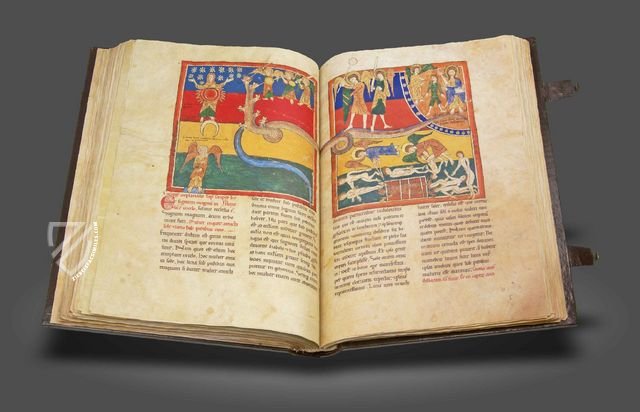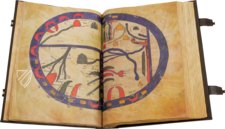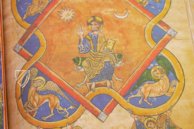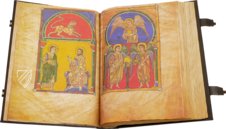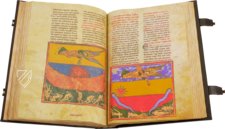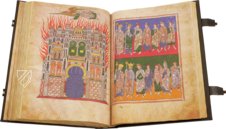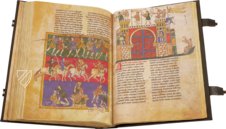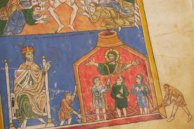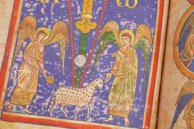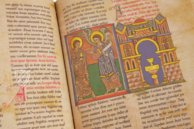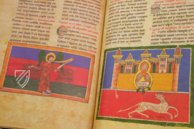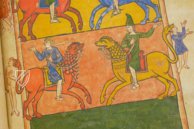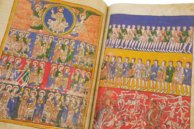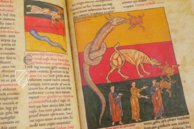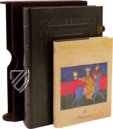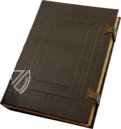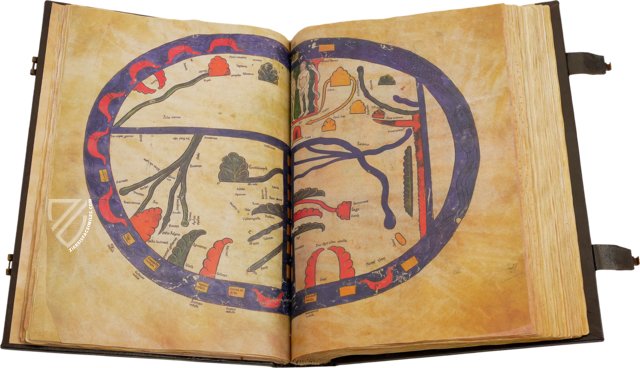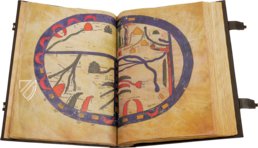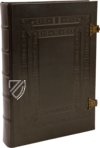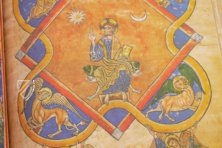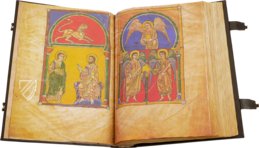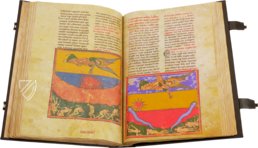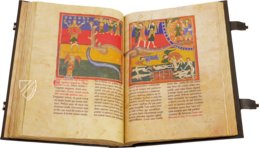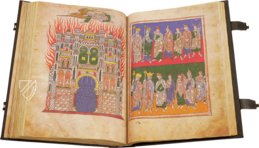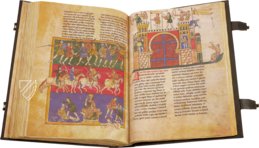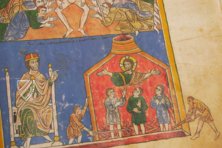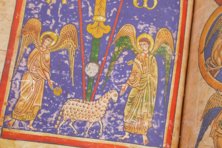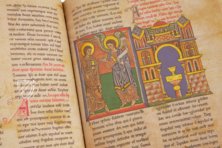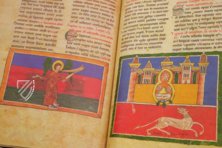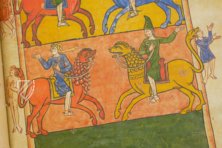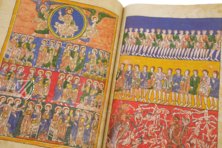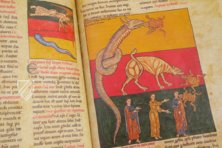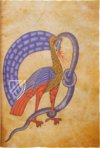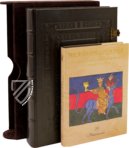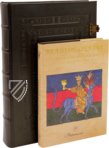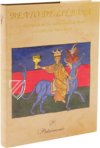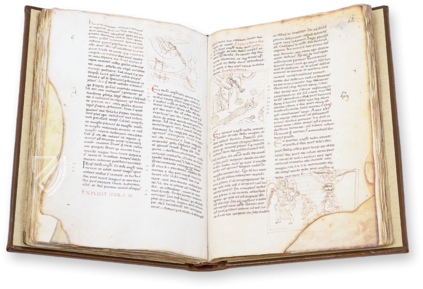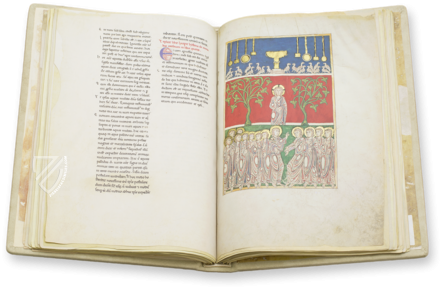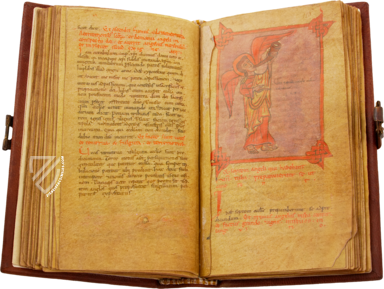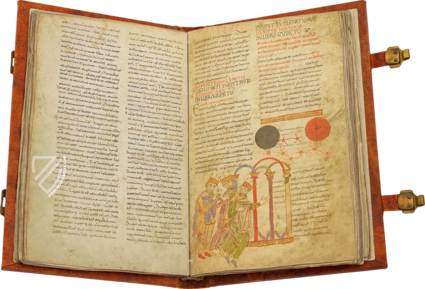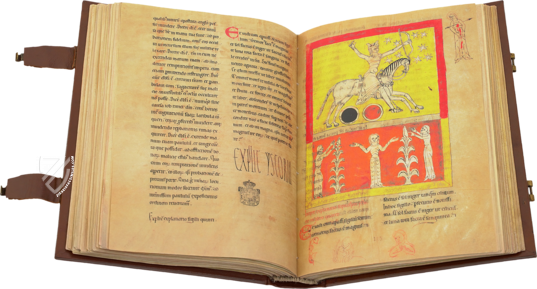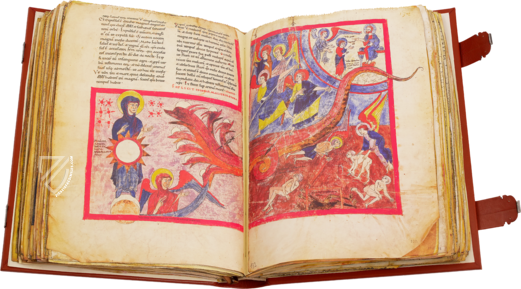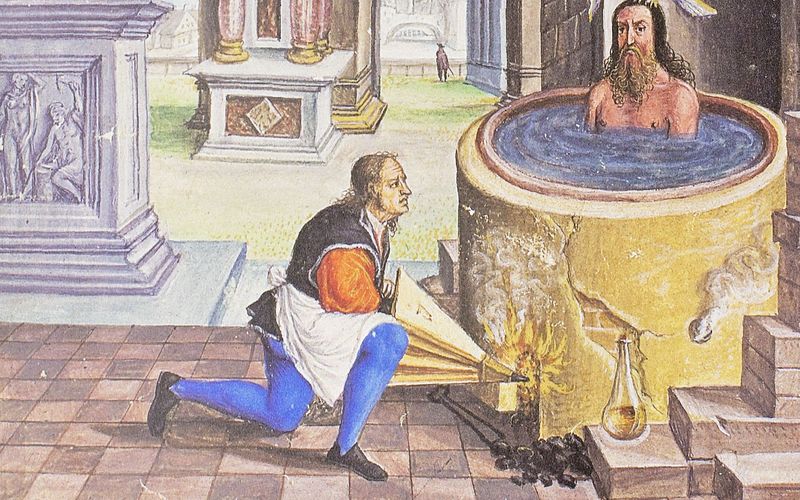Beatus of Liébana - Manchester Codex
(3,000€ - 7,000€)
Originating somewhere between 1170 and 1180, the Manchester Codex of Beatus of Liébana belongs to the late-Romanesque manuscript art of Saint Beatus. In 123 whole-page miniatures, the Book of Revelation and the famous Apocalypse Commentary by the Asturian monk Beatus of Liébana is wonderfully illustrated. Grandiose, magnificently colored miniatures decorate the 510-page codex, which was finely crafted in North-Spain in the tradition of Beatus-manuscripts. The impressive and often gruesome images of the Apocalypse are all illustrated for the enjoyment of the eye of the beholder in this way, e.g. the chasm of Hell or the Fall of Babylon.
Beatus of Liébana – Manchester Codex
Originating somewhere between 1170 and 1180, the Manchester Codex of Beatus of Liébana belongs to the late-Romanesque manuscript art of Saint Beatus. In 123 whole-page miniatures, the Book of Revelation and the famous Apocalypse Commentary by the Asturian monk Beatus of Liébana is wonderfully illustrated. Grandiose, magnificently colored miniatures decorate the 510-page codex, which was finely crafted in North-Spain in the tradition of Beatus-manuscripts. The impressive and often gruesome images of the Apocalypse are all illustrated for the enjoyment of the eye of the beholder in this way, e.g. the chasm of Hell or the Fall of Babylon.
The Masterpiece of Beatus of Liébana
The author of the most well-known and widely distributed apocalypse commentary of the Middle Ages was Beatus of Liébana, a monk and theologian from a monastery in the Kingdom of Asturias in modern Northern Spain. He lived in the 8th Century and died ca. 798. Around the year 800, many feared that the end of the world was nearing during this year of change; in this context this masterpiece by Beatus, a commentary on the Apocalypse of John, also known as the Book of Revelation, appeared. The allegorical and symbolic pictures of the end of the world were thus made easier to understand. In his work, Beatus included staggered sections from different authors, and even cites many of his sources in the text. The text concerning the Apocalypse is divided into 66 sections, which is immediately followed by a so-called explanatio, a commentary from Beatus about the verses. This wealth of narrative imagery is reflected through the miniatures as well. Beatus manuscripts generally contained more than 100 illustrations within the individual sections, the Manchester Codex has about 123.
A Meaningful Testimonial to North-Spanish Art
Wonderful, impressive images decorate the extensive 45 x 31.5 cm codex. Next to the bright colors – wherein the primary colors of red, blue, green, and yellow dominate – the artful design of the miniatures is enhanced with gold and silver. Most whole-page miniatures are also surrounded by a frame. A special feature of the pictures is that some of the figures overlap the boundaries and sprawl across the pages. Stylistically, the pictures appear almost Byzantine, but are actually more comparable to North-Spanish art ca. 1170–1180. The relevant research has come to the consensus that the work enjoyed the input from two artists, who were presumably in Castile, but that the work was definitely finished in Northern Spain.
An Unbelievable Wealth of Pictures
The individual miniatures delight with their creative style of text illustration. Thus, the depictions of Noah’s Arc display a wonderful cross-section of the ship, which appears to have been built like a house. In countless brightly-designed areas, pairs of animals are housed. The dove brings a branch from a green palm tree to the right of the Arc to show Noah that the flood is indeed over. The monochrome animal depictions in the colorful cubes are so creatively crafted that one can hardly believe it. Furthermore, the Manchester Beatus contains a wonderful depiction of a world map, which is illustrated next to Beatus’ text, in which the twelve Apostles spread the Gospel. Another miniature page with a representation of Babylon surrounded by snakes is a great example of the décor. It shows the city as a symmetrical, architectural setting, which is surrounded by winding snakes as an elaborate frame. The artists brought all their skills to fruition and created a special specimen of the Beatus manuscripts, which were so popular in Northern Spain during the Early- and High Middle Ages. Like many of the illustrated manuscripts of the Apocalypse commentary of Beatus von Liébana, the Manchester Codex served as a luxury object of personal prayer. Even today, the beholder can lose himself in the grandiose flood of images.
Codicology
- Alternative Titles
- Beato de Liébana: Códice de Manchester
Manchester Beatus
Beatus de Liébana: Codex de Manchester - Size / Format
- 510 pages / 45.0 × 31.5 cm
- Origin
- Spain
- Date
- 12th century
- Epochs
- Style
- Genre
- Language
- Script
- Gothic
- Illustrations
- 123 beautiful full-page miniatures illuminated in gold and silver
- Content
- Beatus of Liébana's Commentary on the Book of Revelation
- Artist / School
- Beatus of Liébana (died after 798) (author)
- Previous Owners
- Marquis of Astorga and Count of Altamira
Beatus of Liébana - Manchester Codex
Fifth Trumpet: The First Woe
After the fifth angel blows his horn, a bottomless pit opens up producing smoke and locusts like horses prepared for battle with human faces, which have the angel Abaddon as their king and are commanded only to harm those who do not have the seal of God on their foreheads. They do not kill the wicked but torment them by stinging them with their scorpion tails: “In those days men will seek death and will not find it; they will desire to die, and death will flee from them.” (Rev. 9:6)
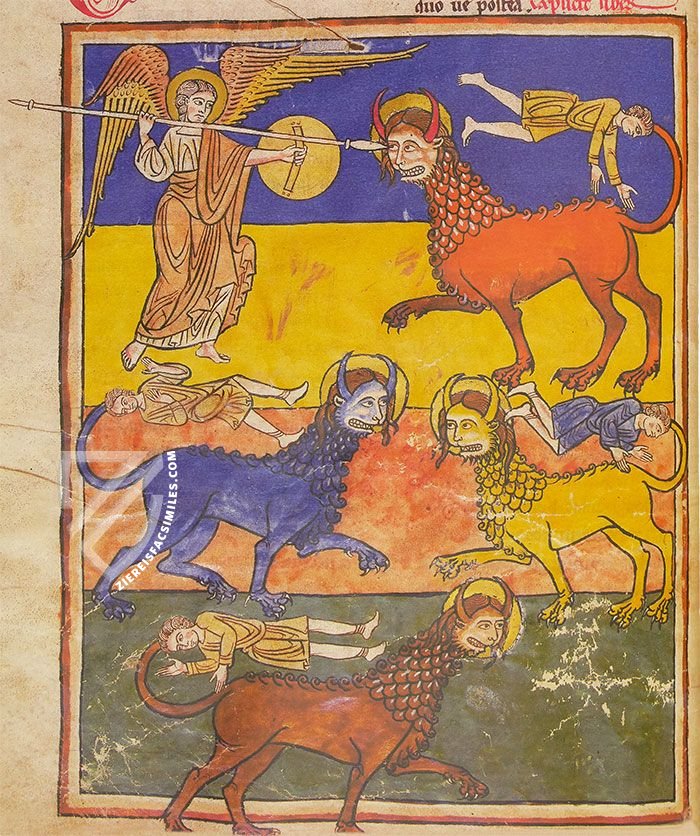
Beatus of Liébana - Manchester Codex
The River of Life and Tree of Life
“And he showed me a pure river of water of life, clear as crystal, proceeding from the throne of God and of the Lamb. In the middle of its street, and on either side of the river, was the tree of life, which bore twelve fruits, each tree yielding its fruit every month. The leaves of the tree were for the healing of the nations.” (Rev. 22:1-2)
The New Heaven and Earth, and New Jerusalem have been established. Christ is shown enthroned, giving the sign of benediction, holding a golden book, and flanked by eighteen horseshoe arches in six rows of three, each with a seated figure. The River of Live flows from between Christ's feet to the Tree of Life below, meanwhile St. John and an angel stand on a mountain to the left observing everything.
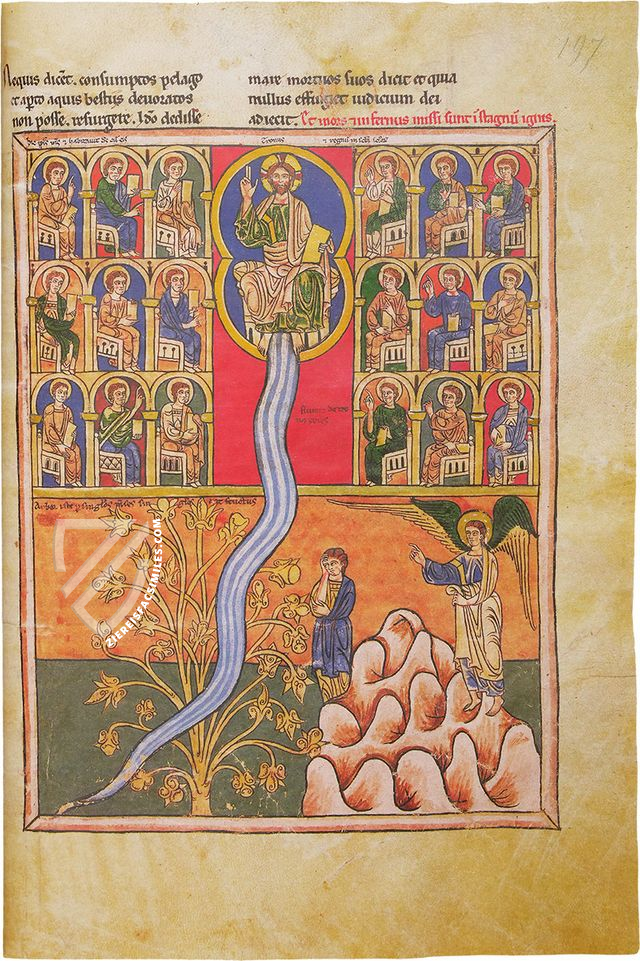
#1 Beato de Liébana: Códice de Manchester
Languages: Spanish, English
(3,000€ - 7,000€)
- Treatises / Secular Books
- Apocalypses / Beatus
- Astronomy / Astrology
- Bestiaries
- Bibles / Gospels
- Chronicles / History / Law
- Geography / Maps
- Saints' Lives
- Islam / Oriental
- Judaism / Hebrew
- Single Leaf Collections
- Leonardo da Vinci
- Literature / Poetry
- Liturgical Manuscripts
- Medicine / Botany / Alchemy
- Music
- Mythology / Prophecies
- Psalters
- Other Religious Books
- Games / Hunting
- Private Devotion Books
- Other Genres
- Afghanistan
- Armenia
- Austria
- Belgium
- Belize
- Bosnia and Herzegovina
- China
- Colombia
- Costa Rica
- Croatia
- Cyprus
- Czech Republic
- Denmark
- Egypt
- El Salvador
- Ethiopia
- France
- Germany
- Greece
- Guatemala
- Honduras
- Hungary
- India
- Iran
- Iraq
- Israel
- Italy
- Japan
- Jordan
- Kazakhstan
- Kyrgyzstan
- Lebanon
- Liechtenstein
- Luxembourg
- Mexico
- Morocco
- Netherlands
- Palestine
- Panama
- Peru
- Poland
- Portugal
- Romania
- Russia
- Serbia
- Spain
- Sri Lanka
- Sweden
- Switzerland
- Syria
- Tajikistan
- Turkey
- Turkmenistan
- Ukraine
- United Kingdom
- United States
- Uzbekistan
- Vatican City
- A. Oosthoek, van Holkema & Warendorf
- Aboca Museum
- Ajuntament de Valencia
- Akademie Verlag
- Akademische Druck- u. Verlagsanstalt (ADEVA)
- Aldo Ausilio Editore - Bottega d’Erasmo
- Alecto Historical Editions
- Alkuin Verlag
- Almqvist & Wiksell
- Amilcare Pizzi
- Andreas & Andreas Verlagsbuchhandlung
- Archa 90
- Archiv Verlag
- Archivi Edizioni
- Arnold Verlag
- ARS
- Ars Magna
- ArtCodex
- AyN Ediciones
- Azimuth Editions
- Badenia Verlag
- Bärenreiter-Verlag
- Belser Verlag
- Belser Verlag / WK Wertkontor
- Benziger Verlag
- Bernardinum Wydawnictwo
- BiblioGemma
- Biblioteca Apostolica Vaticana (Vaticanstadt, Vaticanstadt)
- Bibliotheca Palatina Faksimile Verlag
- Bibliotheca Rara
- Boydell & Brewer
- Bramante Edizioni
- Bredius Genootschap
- Brepols Publishers
- British Library
- C. Weckesser
- Caixa Catalunya
- Canesi
- CAPSA, Ars Scriptoria
- Caratzas Brothers, Publishers
- Carus Verlag
- Casamassima Libri
- Centrum Cartographie Verlag GmbH
- Chavane Verlag
- Christian Brandstätter Verlag
- Circulo Cientifico
- Club Bibliófilo Versol
- Club du Livre
- CM Editores
- Collegium Graphicum
- Collezione Apocrifa Da Vinci
- Comissão Nacional para as Comemorações dos Descobrimentos Portugueses
- Coron Verlag
- Corvina
- CTHS
- D. S. Brewer
- Damon
- De Agostini/UTET
- De Nederlandsche Boekhandel
- De Schutter
- Deuschle & Stemmle
- Deutscher Verlag für Kunstwissenschaft
- DIAMM
- Droz
- E. Schreiber Graphische Kunstanstalten
- Ediciones Boreal
- Ediciones Grial
- Ediclube
- Edições Inapa
- Edilan
- Editalia
- Edition Deuschle
- Edition Georg Popp
- Edition Leipzig
- Edition Libri Illustri
- Editiones Reales Sitios S. L.
- Éditions de l'Oiseau Lyre
- Editions Medicina Rara
- Editorial Casariego
- Editorial Mintzoa
- Editrice Antenore
- Editrice Velar
- Edizioni Edison
- Egeria, S.L.
- Eikon Editores
- Electa
- Emery Walker Limited
- Enciclopèdia Catalana
- Eos-Verlag
- Ephesus Publishing
- Ernst Battenberg
- Eugrammia Press
- Extraordinary Editions
- Fackelverlag
- Facsimila Art & Edition
- Facsimile Editions Ltd.
- Facsimilia Art & Edition Ebert KG
- Faksimile Verlag
- Feuermann Verlag
- Folger Shakespeare Library
- Franco Cosimo Panini Editore
- Friedrich Wittig Verlag
- Fundación Hullera Vasco-Leonesa
- G. Braziller
- Gabriele Mazzotta Editore
- Gebr. Mann Verlag
- Gesellschaft für graphische Industrie
- Getty Research Institute
- Giovanni Domenico de Rossi
- Giunti Editore
- Graffiti
- Grafica European Center of Fine Arts
- Guido Pressler
- Guillermo Blazquez
- Gustav Kiepenheuer
- H. N. Abrams
- Harrassowitz
- Harvard University Press
- Helikon
- Hendrickson Publishers
- Henning Oppermann
- Herder Verlag
- Hes & De Graaf Publishers
- Hoepli
- Holbein-Verlag
- Houghton Library
- Hugo Schmidt Verlag
- Idion Verlag
- Il Bulino, edizioni d'arte
- ILte
- Imago
- Insel Verlag
- Insel-Verlag Anton Kippenberger
- Instituto de Estudios Altoaragoneses
- Instituto Nacional de Antropología e Historia
- Introligatornia Budnik Jerzy
- Istituto dell'Enciclopedia Italiana - Treccani
- Istituto Ellenico di Studi Bizantini e Postbizantini
- Istituto Geografico De Agostini
- Istituto Poligrafico e Zecca dello Stato
- Italarte Art Establishments
- Jan Thorbecke Verlag
- Johnson Reprint Corporation
- Josef Stocker
- Josef Stocker-Schmid
- Jugoslavija
- Karl W. Hiersemann
- Kasper Straube
- Kaydeda Ediciones
- Kindler Verlag / Coron Verlag
- Kodansha International Ltd.
- Konrad Kölbl Verlag
- Kurt Wolff Verlag
- La Liberia dello Stato
- La Linea Editrice
- La Meta Editore
- Lambert Schneider
- Landeskreditbank Baden-Württemberg
- Leo S. Olschki
- Les Incunables
- Liber Artis
- Library of Congress
- Libreria Musicale Italiana
- Lichtdruck
- Lito Immagine Editore
- Lumen Artis
- Lund Humphries
- M. Moleiro Editor
- Maison des Sciences de l'homme et de la société de Poitiers
- Manuscriptum
- Martinus Nijhoff
- Maruzen-Yushodo Co. Ltd.
- MASA
- Massada Publishers
- McGraw-Hill
- Metropolitan Museum of Art
- Militos
- Millennium Liber
- Müller & Schindler
- Nahar - Stavit
- Nahar and Steimatzky
- National Library of Wales
- Neri Pozza
- Nova Charta
- Oceanum Verlag
- Odeon
- Orbis Mediaevalis
- Orbis Pictus
- Österreichische Staatsdruckerei
- Oxford University Press
- Pageant Books
- Parzellers Buchverlag
- Patrimonio Ediciones
- Pattloch Verlag
- PIAF
- Pieper Verlag
- Plon-Nourrit et cie
- Poligrafiche Bolis
- Presses Universitaires de Strasbourg
- Prestel Verlag
- Princeton University Press
- Prisma Verlag
- Priuli & Verlucca, editori
- Pro Sport Verlag
- Propyläen Verlag
- Pytheas Books
- Quaternio Verlag Luzern
- Reales Sitios
- Recht-Verlag
- Reichert Verlag
- Reichsdruckerei
- Reprint Verlag
- Riehn & Reusch
- Roberto Vattori Editore
- Rosenkilde and Bagger
- Roxburghe Club
- Salerno Editrice
- Saltellus Press
- Sandoz
- Sarajevo Svjetlost
- Schöck ArtPrint Kft.
- Schulsinger Brothers
- Scolar Press
- Scrinium
- Scripta Maneant
- Scriptorium
- Shazar
- Siloé, arte y bibliofilia
- SISMEL - Edizioni del Galluzzo
- Sociedad Mexicana de Antropología
- Société des Bibliophiles & Iconophiles de Belgique
- Soncin Publishing
- Sorli Ediciones
- Stainer and Bell
- Studer
- Styria Verlag
- Sumptibus Pragopress
- Szegedi Tudomànyegyetem
- Taberna Libraria
- Tarshish Books
- Taschen
- Tempus Libri
- Testimonio Compañía Editorial
- Thames and Hudson
- The Clear Vue Publishing Partnership Limited
- The Facsimile Codex
- The Folio Society
- The Marquess of Normanby
- The Richard III and Yorkist History Trust
- Tip.Le.Co
- TouchArt
- TREC Publishing House
- TRI Publishing Co.
- Trident Editore
- Tuliba Collection
- Typis Regiae Officinae Polygraphicae
- Union Verlag Berlin
- Universidad de Granada
- University of California Press
- University of Chicago Press
- Urs Graf
- Vallecchi
- Van Wijnen
- VCH, Acta Humaniora
- VDI Verlag
- VEB Deutscher Verlag für Musik
- Verlag Anton Pustet / Andreas Verlag
- Verlag Bibliophile Drucke Josef Stocker
- Verlag der Münchner Drucke
- Verlag für Regionalgeschichte
- Verlag Styria
- Vicent Garcia Editores
- W. Turnowski Ltd.
- W. Turnowsky
- Waanders Printers
- Wiener Mechitharisten-Congregation (Wien, Österreich)
- Wissenschaftliche Buchgesellschaft
- Wissenschaftliche Verlagsgesellschaft
- Wydawnictwo Dolnoslaskie
- Xuntanza Editorial
- Zakład Narodowy
- Zollikofer AG

